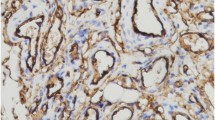Summary
Aim: To compare the expression of p57 as indirect marker of genomic imprinting of CDKN1C in a series of infantile hemangiomas (IH) of patients with and without Beckwith–Wiedemann syndrome. Materials and methods: Cases of mammary, salivary gland, liver (one each), and placental (2 cases) capillary hemangiomas all with histological features akin to IH as well as typical examples of cutaneous (8 cases) IH were analyzed by immunohistochemistry with antibody against p57KIP2. This protein is the product of CDKN1C an imprinted, maternally expressed gene. The liver hemangioma and both chorioangiomas were from patients with Beckwith–Wiedemann syndrome. Positive and negative controls included normal placental tissue and complete hydatidiform mole, respectively. Positive staining was localized to nuclei. Results: Endothelial cells from the skin, breast and salivary gland hemangiomas were p57KIP2 positive while chorioangiomas and liver IH presenting in patients with Beckwith–Wiedemann syndrome were negative. Controls reacted appropriately. Conclusions: Endothelial cells of IH not associated with BWS normally express p57KIP2 while chorioangiomas and IH of the liver associated with BWS do not. These results suggest that the BWS IH may result from dysregulation of the cell cycle.
Similar content being viewed by others
References
T Caspary MA Cleary EJ Perlman P Zhang SJ Elledge SM Tilghman (1999) ArticleTitleOppositely imprinted genes p57(Kip2) and igf2 interact in a mouse model for Beckwith–Wiedemann syndrome Genes Dev 13 3115–3124 Occurrence Handle10.1101/gad.13.23.3115 Occurrence Handle1:CAS:528:DC%2BD3cXhtFOhtg%3D%3D Occurrence Handle10601037
DH Castrillon D Sun S Weremowicz (2001) ArticleTitleDiscrimination of complete hydatidiform mole from its mimics by immunohistochemistry of the paternally imprinted gene product p57KIP2 Am J Surg Path 25 1225–1230 Occurrence Handle10.1097/00000478-200110000-00001 Occurrence Handle1:STN:280:DC%2BD3MnjsFagug%3D%3D Occurrence Handle11688455
MR DeBaun EL Niemitz DE McNeil (2002) ArticleTitleEpigenetic alterations of H19 and LIT1 distinguish patients with Beckwith–Wiedemann syndrome with cancer and birth defects Am J Hum Genet 70 604–611 Occurrence Handle10.1086/338934 Occurrence Handle1:CAS:528:DC%2BD38XislChsb0%3D Occurrence Handle11813134
N Diaz-Meyer CD Day K Khatod ER Maher W Cooper W Reik C Junien G Graham E Algar VM Der Kaloustian MJ Higgins (2003) ArticleTitleSilencing of CDKN1C (p57KIP2) is associated with hypomethylation at KvDMR1 in Book with–Wiedemann syndrome J Med Genet 40 797–801 Occurrence Handle10.1136/jmg.40.11.797 Occurrence Handle1:CAS:528:DC%2BD2cXmtlyitg%3D%3D Occurrence Handle14627666
RM Drut R Drut (1996) ArticleTitleNonimmune fetal hydrops and placentomegaly: diagnosis of familial Wiedemann–Beckwith syndrome with trisomy 11p15 using FISH Am J Med Gen 62 145–149 Occurrence Handle10.1002/(SICI)1096-8628(19960315)62:2<145::AID-AJMG6>3.0.CO;2-V Occurrence Handle1:STN:280:ByiD3snnsVM%3D
R Drut RM Drut JC Toulouse (1992) ArticleTitleHepatic hemangioendotheliomas, placental chorioangiomas, and dysmorphic kidneys in Beckwith–Wiedemann syndome Pediatr Pathol 12 197–203 Occurrence Handle1:STN:280:By2B3sjhslY%3D Occurrence Handle1570237
Drut RM, Drut R (2004) Extracutaneous infantile hemangioma is also Glut1 positive. J Clin Pathol, in press
V Grandjean J Smith PN Schofield AC Ferguson-Smith (2000) ArticleTitleIncreased IGF-II protein affects p57kip2 expression in vivo and in vitro: implications for Beckwith–Wiedemann syndrome Proc Natl Acad Sci USA 97 5279–5284 Occurrence Handle10.1073/pnas.080409297 Occurrence Handle1:CAS:528:DC%2BD3cXjsVWntbw%3D Occurrence Handle10779549
K Higashimoto T Urano K Sugiura (2003) ArticleTitleLoss of CpG methylation is strongly correlated with loss of histone H3 lysine 9 methylation at DMR-LIT1 in patients with Beckwith–Wiedemann syndrome Am J Hum Genet 73 948–956 Occurrence Handle10.1086/378595 Occurrence Handle1:CAS:528:DC%2BD3sXotF2hs7o%3D Occurrence Handle12949703
S-Y Jun JY Ro K-R Kim (2003) ArticleTitlep57kip2 is useful in the classification and differential diagnosis of complete and partial hydatidiform moles Histopathology 43 17–25 Occurrence Handle10.1046/j.1365-2559.2003.01667.x Occurrence Handle12823708
PE North M Waner A Mizeracki MC Mihm SuffixJr (2000) ArticleTitleGLUT1: a newly discovered immunohistochemical marker for juvenile hemangiomas Human Pathol 31 11–22 Occurrence Handle1:CAS:528:DC%2BD3cXptVegtw%3D%3D
PE North M Waner A Mizeracki RE Mrak (2001) ArticleTitleA unique microvascular phenotype shared by juvenile hemangiomas and human placenta Arch Dermatol 137 1–12
North P, Kozakewich H (2003) Vascular Malformations and Tumors in Children. Society for Pediatric Pathology. Annual Meeting Workshop Handout. Washington, DC. March 22–23
Author information
Authors and Affiliations
Corresponding author
Rights and permissions
About this article
Cite this article
Drut, R., Drut, R.M. Expression of p57KIP2 in infantile hemangioma. J Mol Hist 36, 195–197 (2005). https://doi.org/10.1007/s10735-005-2255-5
Received:
Accepted:
Issue Date:
DOI: https://doi.org/10.1007/s10735-005-2255-5




